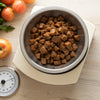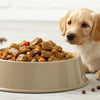How Much Wet Dog Food Should My Dog Eat? A Comprehensive Guide for Caring Pet Parents
- Houndsy
Table of Contents
- Introduction
- Understanding Your Dog's Nutritional Needs
- How Much Wet Dog Food Should My Dog Eat?
- Puppies and Senior Dogs
- Calculating Individual Portions
- Enhancing Your Feeding Experience
- Frequently Asked Questions (FAQ)
- Conclusion
Introduction
Did you know that nearly 56% of dogs in the United States are overweight or obese? This startling statistic underscores the importance of monitoring our furry friends' diets closely, particularly when it comes to wet dog food. As pet owners, we want to provide our dogs with the best care possible, ensuring they receive the right nutrients to thrive without overindulging them.
In this blog post, we will explore the essential factors that determine how much wet dog food your pet should eat. Delving into details about age, weight, activity level, and dietary needs, we'll provide a thorough understanding of pet nutrition that can enhance your dog's well-being. By the end of this article, you'll have the tools to create a balanced, nutritious diet for your four-legged companion, and a clear answer to the question: how much wet dog food should my dog eat?
We will also introduce you to our innovative solution—the Houndsy Kibble Dispenser—which simplifies the feeding routine and ensures your pet receives perfectly portioned meals every time. So, let's dive into the details of dog nutrition!
Understanding Your Dog's Nutritional Needs
Factors Influencing Diet
Before diving into specifics about wet food portions, it's essential to understand the key factors that influence how much wet dog food your dog should eat:
-
Weight: The size of your dog has a direct impact on how much they should consume. Larger dogs require more food than small breeds.
-
Age: Puppies, adults, and senior dogs have different nutritional requirements. Puppies require more calories and protein to support growth, whereas seniors often need fewer calories due to decreased activity levels.
-
Activity Level: A dog’s lifestyle significantly affects their dietary needs. Active dogs burn more calories and therefore require more food to maintain their weight.
-
Health Status: Dogs with certain health conditions may need special diets, which can impact the quantity and type of food they should eat.
Daily Caloric Needs
On average, dogs need approximately 25-30 calories per pound of body weight each day. For example, a 20-pound dog might require 500-600 calories daily. However, there are variances based on factors like the dog's health and activity levels.
Wet Dog Food Versus Dry Dog Food
It's also important to differentiate between wet and dry dog food. Wet food is typically more palatable for dogs, which can be beneficial for picky eaters or those with dental issues. Moreover, it usually has a higher moisture content, which can aid in hydration. However, it might also contain more calories per ounce compared to dry food, so proper portion control is vital.
How Much Wet Dog Food Should My Dog Eat?
General Guidelines
Most commercially available wet dog foods provide feeding guidelines based on your dog's weight. It's primarily recommended to follow these guidelines as a starting point. Here’s a simplified feeding guide to help determine how much wet food your dog may need:
- Under 10 lbs: 1/2 can per day
- 10-20 lbs: 1 can per day
- 20-30 lbs: 1 3/4 can per day
- 30-50 lbs: 2 1/2 cans per day
- 50-70 lbs: 3 1/2 cans per day
- 70+ lbs: 4 1/2 cans per day
Specific Adult Dog Portion Example
Let’s break it down with a practical example: For a 50-pound dog, if the wet food label recommends 1 can per 10 pounds of body weight daily, that would mean your dog should ideally receive about 5 cans a day.
Remember to Adjust for Mixed Diets: If you're mixing wet food with dry kibble, it's essential to account for the caloric value of both food types. A rough rule of thumb is that adding a full can of wet food can replace roughly 1–1.5 cups of dry food, depending on the product's caloric density.
Puppies and Senior Dogs
Feeding Puppies
Puppies have unique nutritional needs and typically require higher caloric intake compared to adult dogs. Here's a basic guideline for feeding wet dog food to puppies:
- Under 3 months: 2-3 cans per day, depending on size.
- 3-6 months: 1 can per 4-5 lbs of body weight, split into 3 feeds.
- 6 months to adult: Transitioning to adult portions can often begin around 12 months.
Puppies grow quickly and need nutrient-dense food to support their development, so consulting your veterinarian for tailored advice is crucial during this phase.
Senior Dogs
As dogs age, their metabolism slows and they may become less active. This generally requires a reduction in caloric intake. It's also common for senior dogs to benefit from wet food's softer texture, making it easier for them to chew and digest.
A practical approach is to cut their food portions by around 10-20% compared to adult recommendations, but always observe their weight and health conditions closely. Consult with your veterinarian to ensure you're meeting their specialized dietary needs, particularly concerning joint health and possible digestion challenges.
Calculating Individual Portions
Once you understand the general guidelines, calculating your dog's specific portion size becomes crucial. Here's a simple step-by-step method to determine the right amount:
- Determine Your Dog’s Ideal Weight: Consult with your vet to find out their ideal weight.
- Refer to Wet Food Guidelines: Check the specific feeding guidelines provided by your dog food label.
- Adjust For Activity Level: If your dog is particularly active, consider slightly increasing their portions.
- Mixing Wet with Dry Food: For wet and dry mixes, remember to decrease the dry food portion accordingly (i.e., halve the kibble amount when adding a full can of wet food).
Sample Calculation
Consider a 30 lb adult dog:
- Ideal daily caloric intake could be ~600-900 calories, depending on activity levels.
- If using a wet food labeled at 250 calories per can, the dog would require about 2-3 cans.
- Adjust for any dry food being mixed in and consider specific needs based on health.
Enhancing Your Feeding Experience
At Houndsy, we believe that feeding time should be both a convenience and a joy for pet parents and their furry companions. Our flagship product, the Houndsy Kibble Dispenser, streamlines the feeding process. With its stylish mid-century modern design and ergonomic features, we ensure your pup gets the perfect portions without the mess or hassle.
- Convenient Crank System: Our dispenser features a crank at a standing height, making it easy to serve portions without bending.
- Perfect Portion Control: The auto-locking mechanism helps prevent accidental dispensing, ensuring no more spilled food.
- A Visual Appeal: Its design seamlessly complements any modern home decor, making feeding time beautiful.
Our Houndsy Kibble Dispenser takes the worry out of feeding, so you can focus on spending quality time with your beloved pets.
Frequently Asked Questions (FAQ)
1. Can I mix wet and dry dog food together?
Yes, mixing wet and dry food can add variety to your dog’s diet. When doing so, adjust the portions of each to avoid overfeeding. For every half can of wet food, consider reducing the dry food portion accordingly to maintain balanced nutrition.
2. How do I know if I’m feeding my dog too much or too little?
Monitor your dog's weight and body condition regularly. A weight gain or loss pattern indicates that you may need to adjust their diet. Consult your veterinarian for tailored advice if you're unsure.
3. Should I change my dog's diet as they age?
Yes, dogs often need different nutrition as they transition from puppies to adults and then seniors. As dogs age, you may need to decrease their caloric intake and adjust their diet to aid joint health and manage weight.
4. Is wet dog food enough for my dog's nutritional needs?
Wet dog food can be nutritionally sufficient, but be sure to choose high-quality options that meet AAFCO guidelines. Consult your veterinarian to ensure that you're providing a balanced diet, especially if using wet food as the main component.
5. How frequently should I feed my dog?
Most adult dogs do well on two meals per day. Puppies, depending on their age, may require three to five smaller meals throughout the day due to their high metabolism.
Conclusion
Understanding how much wet dog food your dog should eat is crucial to their health and well-being. By considering their weight, age, activity level, and dietary needs, you can create a feeding routine that meets their specific requirements. Investing in quality food and incorporating tools like the Houndsy Kibble Dispenser can elevate the feeding experience both for you and your canine companion. Adopting these practices ensures that your dog enjoys a happy, healthy life filled with delicious meals, supporting their well-being every step of the way.
Is it time to re-evaluate your dog’s feeding routine? If so, consider exploring the Houndsy Kibble Dispenser to make feeding more convenient and enjoyable, keeping mealtimes joyful and mess-free!












